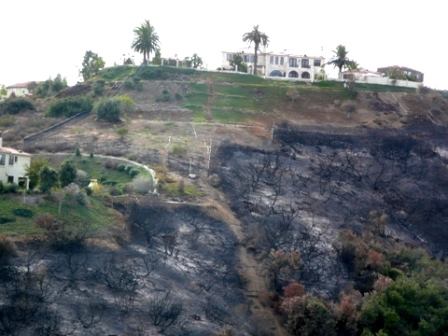Each house in a SIP community must be built to the same standards, aimed at preventing embers and firebrands from coming into contact with structures. Most homes lost in fires were ignited by flying firebrands or embers infiltrating their exteriors through vents or the roof material. So the first elements of a SIP house are Class A non-combustible roofing materials, chimneys with spark arrestors using ½-inch screening, and eaves of boxed construction or of heavy timber (as vented eaves allow sparks and embers to enter the structure).
Fire sprinklers, dual-pane or tempered-glass windows, and fire-resistant siding and decking materials also must be used. Communities must have adequate water supplies for firefighting and roads and driveways must accommodate two-way traffic and firefighting vehicles.
A minimum 100-foot defensible perimeter (already required by California’s codes) must be created and maintained around each house, the first 50 feet landscaped with non-flammable plants and irrigated, the second 50 feet cleared of flammable vegetation. The community also has to be surrounded by a vegetation-modification zone. Because of such buffer zones around and within Cielo, one of the five undamaged communities, there was no fuel for the Witch Creek fire to burn, so its progress into the partially developed neighborhood was halted, according to Donna Medrea, a Realtor who represents the Cielo development.
The defensible perimeter must be maintained year-round by everyone in the community, and maintenance is usually overseen by the homeowner association or property management entity. “It’s a community effort. If you do all the right things around your house but your neighbor does all the wrong things, then your house is at risk,” points out former wildland firefighter Dave Bacon, now president of Firewise 2000 Inc., a fire protection consulting firm.
The idea is that able-bodied homeowners can safely remain in their homes during a wildland fire rather than evacuating. During the fire, those sheltering in place—educated and trained by the fire department—can take measures to fight any small fires that may get past their property’s perimeter, as well as help neighbors and discourage looters, a growing problem during fire evacuations.
In Australia, this practice is accepted and routinely followed in communities built near high-risk fire zones. However, Rancho Santa Fe’s fire officials advise even those living in SIP communities to evacuate when ordered as this allows firefighters to focus their attention on suppressing the fire rather than on saving lives.
In an ideal world, home disasters such as those caused by the wildfires of last fall would be prevented, perhaps by limiting development near wildland areas. But as this is unlikely to happen, Shelter-in-Place building practices may be the next best option for protecting entire communities against fire. As Bacon says, in California “we have to learn to live with fire, because it is going to be part of our environment.”



